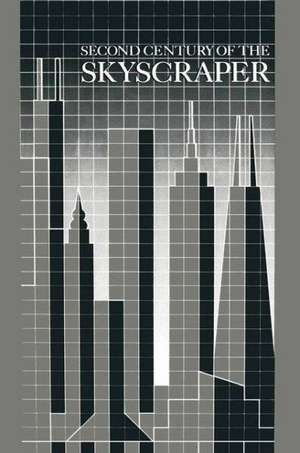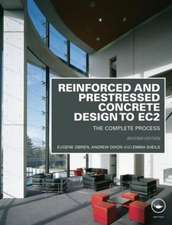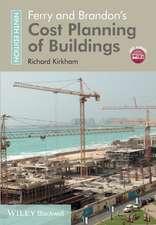Second Century of the Skyscraper: Council on Tall Buildings and Urban Habitat
Autor Council on Tall Buildings & Urbanen Limba Engleză Paperback – 24 noi 2012
Preț: 981.76 lei
Preț vechi: 1197.27 lei
-18% Nou
Puncte Express: 1473
Preț estimativ în valută:
187.85€ • 196.67$ • 155.44£
187.85€ • 196.67$ • 155.44£
Carte tipărită la comandă
Livrare economică 08-22 aprilie
Preluare comenzi: 021 569.72.76
Specificații
ISBN-13: 9781468465839
ISBN-10: 146846583X
Pagini: 1140
Ilustrații: XXV, 1108 p.
Dimensiuni: 152 x 229 x 60 mm
Greutate: 1.49 kg
Ediția:Softcover reprint of the original 1st ed. 1988
Editura: Springer Us
Colecția Springer
Locul publicării:New York, NY, United States
ISBN-10: 146846583X
Pagini: 1140
Ilustrații: XXV, 1108 p.
Dimensiuni: 152 x 229 x 60 mm
Greutate: 1.49 kg
Ediția:Softcover reprint of the original 1st ed. 1988
Editura: Springer Us
Colecția Springer
Locul publicării:New York, NY, United States
Public țintă
ResearchDescriere
tenant is looming in importance. The owner is having more influence on the building. As Gerald D. Hines has said, there are indications that the desire for more discretionary time will lead to more residential high-rises dose to or in the midst of downtown office buildings. Downtown living could become the desired alternative. Tall buildings will be approached increasingly from the standpoint of an urban ecology - that what happens to apart can influence the whole. Provid ing for public as well as private needs in a tall building project is just one example (facilities for schools, shops, religious, and other needs). More attention will be paid to maintaining streets as lively and interesting places. Will a new "world's tallest" be built? Will we go a mile high? The answer is probably "yes" to the first, "no" to the second. With the recent spate of super-tall buildings on the drawing boards, going to greater heights was in the back of many people's minds at the Chicago conference. But in the U nited States, at least, buildings of 70 to 80 stories would appear to provide needed space consistent with economy. The future, then, is described in depth by papers that go into specific areas.
Cuprins
Planning and Environmental Criteria.- Introductory Review.- Philosophy of Tall Buildings.- The Philosophy and the Future of the Skyscraper.- History of Tall Buildings.- The Two Centuries of Technical Evolution Underlying the Skyscraper.- The Relative Value of Invention and the History of Tall Buildings.- Evolution of the Skyscraper: A History of the Tall Building in Chicago.- Social Effects of the Environment.- Time’s Arrow: Tall Moving Targets and Social Research.- Social and Environmental Factors of High-Rise Living: A Singapore Experience.- Socio-Political Influences.- The Urban Ecology of Tall Buildings.- Economics.- A Preliminary Model for the Economic Analysis of Tall Buildings.- Architecture.- Architecture and Society.- Tall Buildings as Symbols.- Considerations for Urban Architecture and the Tall Building.- A Perspective on Architectural Directions.- The Architecture of Large Buildings.- Impact of European Technical Culture on the Development of Tall Building Architecture.- Interior Design.- Building Design Consultation.- The Inside Story: How Structure and Services Impact Office Design in Tall Buildings.- Urban Planning and Design.- Chicago Update.- San Francisco Downtown Plan and the Skyscraper.- The Chicago Perspective: Response to the San Francisco Plan.- The San Francisco Downtown Plan: A Tale of Two Cities.- Tall Buildings, Tight Streets.- Skylobbies as Interconnecting Links Amid the Cluster of Skyscrapers.- Project Management.- Project Management for Tall Buildings and Urban Habitat.- Scheduling Tall Buildings.- Tall Buildings in Developing Countries.- High-Rise Development in India.- Development and Investment.- Developing Tall Buildings to Meet Future Needs: Transco Tower Case History.- Systems and Concepts.- Introductory Review.- Structural Systems.- The Composite High-Rise Building—An Interaction of Planning, Structure, Speed, and Economy.- A Tall Building of Stacked Steel and Concrete Structures.- A Tall Building Core-Hanger Interaction System.- Transfer Structures.- Investigation and Prevention of Failures.- Cladding.- Design of Glass Against Breakage.- Construction Systems.- Innovations in High-Rise Construction.- Times Square Office Center: The Story of a High-Rise Complex.- Foundation Design.- Recent Improvements in Foundations.- High-Rise Housing.- High-Rise Public Housing Development in Singapore.- Demand for High-Rise Housing in the United States.- A Comparison of High-Rise Housing in India with Industrialized Countries.- Prefabricated Tall Buildings.- Prefabricated Concrete Systems.- INTEGRO: Open-Element Prefabricated Construction System.- Robots and Tall Buildings.- Construction Robotics in Japan.- Application of Systems Methodology.- Computer Integrated Facilities Management.- Reduce Operating Expenses by Computerizing Facilities Management.- Perceptions of the Computer in Design.- Role of Expert Systems in High-Rise Building Design.- Knowledge-Based Systems for Tall Buildings.- Building Service Systems.- Introductory Review.- Heating, Ventilating, and Air Conditioning (HVAC).- High-Rise Office Buildings: Changes Anticipated by the Year 2000.- Vertical and Horizontal Transportation.- Energy Consumption and Power Requirements of Elevators.- Space-Saving Elevators for the Very Tall Building.- High-Tech Tall Buildings.- Current and Future Trends: The New Age of Buildings.- Criteria and Loading.- Introductory Review.- Earthquake Loading and Response.- Behavior of Structures Retrofitted with Diagonal Steel Bracings During the 1985 Mexico City Earthquake.- Damage Statistics of the September 19, 1985 Earthquake in Mexico City.- Effects of the September 19, 1985 Earthquake on the Buildings of Mexico City.- Lessons of the Mexico City Earthquake.- Wind Loading and Wind Effects.- Definition of Wind Pressure on Tall Buildings.- Air Infiltration and Internal Pressures in Tall Buildings.- Effects of Higher Modes on Response of Wind-Excited Tall Buildings.- The Response of Supertall Buildings to Wind.- Fire.- Fire Safety Design for Tall Buildings: Recent Developments.- Structural Safety and Quality Assurance.- Safety, Quality Assurance, and Performance.- Structural Safety: Some Problems of Achievement and Control.- Motion Perception and Tolerance.- Motion in Tall Buildings.- Damping in Tall Buildings.- The Role of Damping Systems.- Structural Design of Tall Steel Buildings.- Introductory Review.- Commentary on Structural Standards.- Structural Standards.- Methods of Analysis and Design.- Seismic Design of Tall Steel Buildings.- Stability.- Design for Strength (Stability).- Design Methods Based on Stiffness.- Adaptive Expert System for Preliminary Design of Wind Bracings in Steel Skeleton Structures.- Connections.- Connection Flexibility in Steel Frames.- Load and Resistance Factor Design (Limit States Design).- Serviceability Limits for Tall Buildings.- Structural Design of Tall Concrete and Masonry Buildings.- Introductory Review.- Commentary on Structural Standards.- Building Codes.- Selection of Structural Systems.- Concrete Buildings—A Mile High.- Elastic Analysis.- Methods of Analysis in the Design of Tall Concrete and Masonry Buildings.- Precast Panel Structures.- Precast and Prestressed Concrete Directions in Australia and Southeast Asia.- Creep, Shrinkage, and Temperature Effects.- Deterioration of Concrete.- Masonry Structures.- U. S. Coordinated Program for Masonry Building Research.- Project Descriptions.- Superstructure of OUB Centre, Singapore.- The Skyscraper’s Base: Architecture, Landscape and Use in the Dallas Arts District.- Append.- High-Rise Building Data Base.- Nomenclature.- Symbols.- Abbreviations.- Units.- References/Bibliography.- Building Index.- Name Index.









